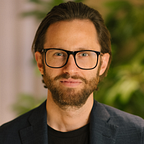Sam Altman’s “one-person unicorn” and the future of the office
Back in January 2024, OpenAI’s Sam Altman captured headlines for his speculation at the coming of the world’s first one-person billion-dollar company, enabled by advances in AI. This follows a series of notably low-headcount businesses reaching this status in the past, including Instagram’s 2012 sale to Facebook (with a 13-person headcount).
Technology and automation have had a longstanding impact on employee headcount, with industrial and agricultural examples dating back generations (even centuries). Critics of automation gesture to the short-run impacts on workers and families, including unemployment, downtime to reskill, and relocation. The obverse argument is that automation of repetitive and less desirable work has created longer-run employment opportunities for workers. Consequently, white and grey collar work have grown in proportion to all work over recent decades. So too has tertiary education (visualised below).
Headcounts and demand for space
This side of the new millennium, data supports the notion that lower headcounts abound. UK companies with no employees saw more growth than other sized businesses from 2000 to 2022, including the disproportionate shakedown of leaner businesses during the COVID era (visualised below). The outcome is familiar to the real estate sector. With more firms comprising fewer employees (not to mention hybrid and/or remote workers), the average demand for space per company is both lower and more dynamic. This gave rise to the space-as-a-service movement we have become familiar with, including the likes of WeWork, FORA, and before them, Regus. Obviously, not all of these models have avoided controversy.
The outlook for shrinking headcounts
In the “future of work” arena, much attention has been directed toward the outlook for jobs threatened by automation. WEF’s 2020 The Future of Jobs Report expected 85 million jobs globally to be affected by “automation and a new division of labour between humans and machines” by 2025. Notably pre-dating the ChatGPT-induced genAI boom, emphasis is placed on the redundancy of physical labour and repetitive tasks. The report’s summary states that in 2025, “analytical thinking, creativity and flexibility are among the top skills needed; with data and artificial intelligence, content creation and cloud computing the top emerging professions”. Alongside most of us, WEF contributors had changed their tune by 2023, citing a Goldman Sachs study claiming 26 percent of tasks can now be automated in the arts and design sector because of genAI. With more drivers of shrinking headcounts, what does the future of the workplace look like from here?
The future of the workplace
There have been many predictions about where workplaces go from here — from extended reality to more of the space-as-a-service we have grown accustomed to. I’m intrigued by a separate phenomenon unfolding without much attention: swelling member’s clubs. In 2021, the famed Soho House group of private members clubs was listed on the New York Stock Exchange. With a heightened profit incentive, the group was soon criticised for diverging from its creative roots by accepting applications from a broader subset of professions. By 2024, complaints of overcrowding had grown so loud that new memberships have been embargoed in places like London and New York. Anecdotal feedback from club members indicates this applies nearly as much to business hours as to peak times on Friday and Saturday nights. This comes at a time office vacancies persist in many global cities, but it is important to note that Soho House has purportedly “not earned a profit in 28 years”.
Hotelisation-upon-hotelisation
The rise and rise of member’s clubs presents an interesting challenge to the commercial real estate sector: exactly how far can they take the hotelisation of the workplace movement? Will occupiers, especially the growing proportion of companies with lean or distributed teams, choose a member’s club over a cordoned off section of a flexible workspace? Will the disruptor become the disrupted? Will the world’s first one-person unicorn be built and operated from a cosy chesterfield in a quiet corner of a London or New York member’s club..?
Thanks to Valentina Shegoyan (OPREIM); Ian Minor, Rachel Lupiani and Caleb Parker (Brave Corporation); Bogdan Nicoara and Adam Ghadiali (Bright Spaces); and James Pellatt for their helpful insights.
